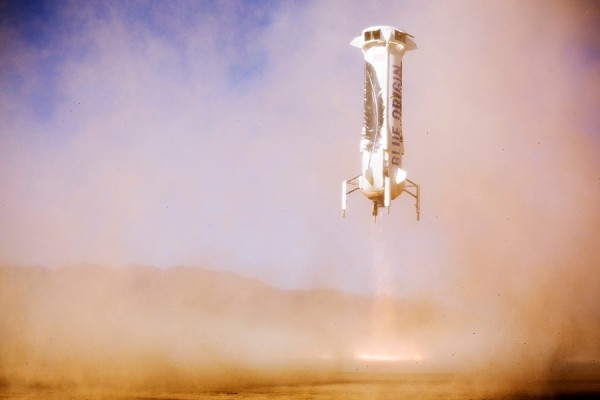By Ana Verayo, | January 25, 2016

Blue Origin’s New Shepard booster executes a controlled vertical landing at 4.2 mph.
Amazon's Jeff Bezos' new aerospace company, Blue Origin just conducted its second successful landing of one of its reusable rockets, during a test launch last Friday, leaving SpaceX behind as the private space company only had one successful landing of its reusable rocket after a satellite launch in lower Earth orbit.
Like Us on Facebook
These latest rocket tests presents the New Shepard spacecraft, which is also the same model that was launched to conduct the first successful reusable rocket test of Blue Origin last November. The rocket landed vertically on its target landing site.
Officials from Blue Origin revealed that last week's rocket test launched the New Shepard at a maximum altitude of 333,582 feet where mission control safely guided and recovered the rocket back to land for further reuse.
Using the data collected from the last November launch, the same data coincided with the preflight predictions by the team from Blue Origin. This was also pivotal in the success of this second test flight, making preflight preparations easier for quicker turnaround.
Apart from this, there were several adjustments made for New Shepard's configurations that involved replacement of crew capsule parachutes and pyro igniters along with avionics and functional checkouts. The Blue Origin team also improved the New Shepard's software by detecting first the center point of its target landing site before it lands as opposed to the most convenient landing spot in the area.
This helps the New Shepard in prioritizing altitude with its exact lateral positioning upon landing. This can be compared to lining up an airplane the centerline of the runway upon landing at the airport.
According to CEO and founder Jeff Bezos, when the lane is a few feet far from the center, the airplane does not swerve on the last minute to make a successful landing on the exact middle of the runway. Instead, the best way to land is a few feet left or right of the center line.
Simulations of the rocket demonstrated a successful landing strategy, allowing the team more room to be flexible, improving the ability of the spacecraft to withstand weather disturbances such as strong, low altitude winds.
This also marks the first time that a commercial rocket was able to reach lower Earth orbit for the second time where Blue Origin's test launches appears to be the sign of things to come, rivaling Elon Musk's SpaceX, that successfully landed its reusable Falcon 9 rocket last December.
However, just last week, SpaceX conducted another rocket landing after a satellite launch, where it tipped over and fell, exploding on the landing site which is a droneship off the coast of California.
-
Use of Coronavirus Pandemic Drones Raises Privacy Concerns: Drones Spread Fear, Local Officials Say

-
Coronavirus Hampers The Delivery Of Lockheed Martin F-35 Stealth Fighters For 2020

-
Instagram Speeds Up Plans to Add Account Memorialization Feature Due to COVID-19 Deaths

-
NASA: Perseverance Plans to Bring 'Mars Rock' to Earth in 2031

-
600 Dead And 3,000 In The Hospital as Iranians Believed Drinking High-Concentrations of Alcohol Can Cure The Coronavirus

-
600 Dead And 3,000 In The Hospital as Iranians Believed Drinking High-Concentrations of Alcohol Can Cure The Coronavirus

-
COVID-19: Doctors, Nurses Use Virtual Reality to Learn New Skills in Treating Coronavirus Patients







